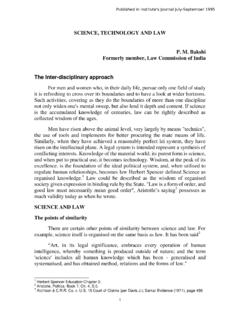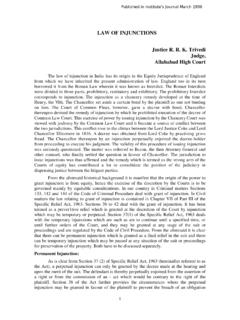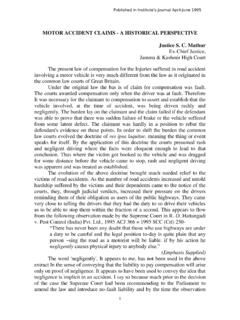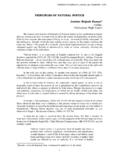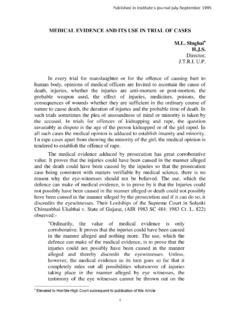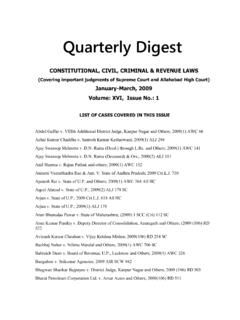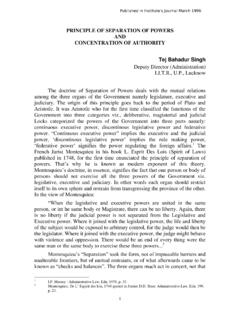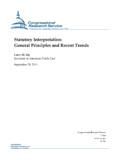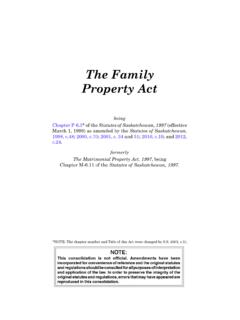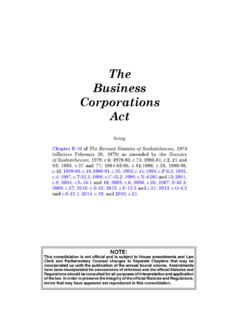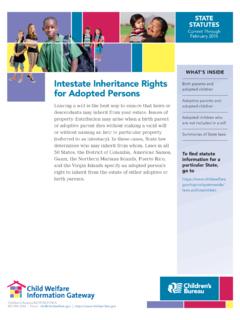Transcription of INTERPRETATION OF STATUTES Justice A.K. Srivastava, Judge ...
1 1 INTERPRETATION OF STATUTES Justice Srivastava, Judge , Delhi High Court at New Delhi Words spoken or written are the means of communication. Where they are possible of giving one and only one meaning there is no problem. But where there is a possibility of two meanings, a problem arises and the real intention is to be sorted out. It two persons communicating with each other are sitting together; they can by subsequent conversation clear the confusion and make things clear. But what will happen if a provision in any statute is found to convey more than one meaning? The Judges and the Lawyers whose duty it is to interpret STATUTES have no opportunity to converse with the Legislature which had enacted a particular statute. The Legislature, after enacting STATUTES becomes functus officio so far as those STATUTES are concerned. It is not their function to interpret the STATUTES . Thus two functions are clearly demarcated. Legislature enacts and the Judges interpret.
2 The difficulty with Judges is that they cannot say that they do not understand a particular provision of an enactment. They have to interpret in one way or another. They cannot remand or refer back the matter to the Legislature for INTERPRETATION . That situation led to the birth of principles of INTERPRETATION to find out the real intent of the Legislature. Consequently, the Superior Courts had to give us the rules of INTERPRETATION to ease ambiguities, inconsistencies, contradictions or lacunas. The rules of INTERPRETATION come into play only where clarity or precision in the provisions of the statute are found missing. Good enactments are those which have least ambiguities, inconsistencies, contradictions or lacunas. Bad enactments are gold mine for lawyers because for half of the litigation the legislative draftsmen are undoubtedly the cause. The purpose of the INTERPRETATION of the statute Is to unlock the locks put by the Legislature.
3 For such unlocking, keys are to be found out. These keys may be termed as aids for INTERPRETATION and principles of INTERPRETATION . The aids for INTERPRETATION may be divided into two categories, namely, Internal and External. The Internal Aids are those which are found within the statute. They may be as follows:- 1. Long title of the statute. 2. Preamble of the statute. 3. Chapter Headings of the statute. 4. Marginal Notes to every section of statute. 5. Punctuations. 6. Illustrations given below the sections. 7. Definitions. 8. Provisos. 9. Explanation. 10. Saving Clauses and non-obstante Clauses. 4 YFPMWLIH MR -RWXMXYXI W .SYVREP .YP] 7 ITXIQFIV 2 External Aid for INTERPRETATION are those which are not contained in the statute but are found else-where. They may be as follows:- 1. Historical background. 2. Statement of objects and reasons. 3. The original Bill as drafted and introduced. 4. Debates in the Legislature. 5. State of things at the time a particular legislation was enacted.
4 6. Judicial construction. 7. Legal dictionaries. 8. Commonsense. As stated above, the Superior Courts have formulated certain principles of INTERPRETATION to find out the real intent of. the Legislature. These principles may be enumerated as follows:- 1. Literal construction In construing a statutory provision the first and the foremost rule of construction is that of literal construction. All that the Court has to see at the very outset is, what does the provision say? The Courts are bound by the mandate of the Legislature and once it has expressed its intention in words which have a clear significance and meaning, the Court is precluded from speculating. If the provision is unambiguous and if from that provision the legislative intent is clear, the other rules of construction of STATUTES need not be called into aid. They are called into aid only when the legislative intention is not clear. But the courts would not be justified in so straining the language of the statutory provision as to ascribe the meaning which cannot be warranted by the words employed by the Legislature.
5 2. No external aid Where words plain and unambiguous- Where the words of a statute are plain, precise and unambiguous, the intention of the Legislature is to be gathered from the language of the statute itself and no external aid is admissible to construe those words. It is only where a statute is not exhaustive or where its language is ambiguous, uncertain, clouded or susceptible of more than one meaning or shades of meaning that the external aid may be looked into for the purpose of ascertaining the object which the Legislature had in view in using the words in question. 3. Mischief rule (Heydon's case)- When a question arises as to the INTERPRETATION to be put on an enactment, what the Court is to do is to ascertain "the intent of them that make it," and that must of course be gathered from the words actually used in the statute. That, however, does not mean that the decision should rest on a literal INTERPRETATION of the words used in disregard of all other materials.
6 The literal construction, then, has, in general, but prima facie preference. To arrive at the real meaning, it is always necessary to get an exact conception of the aim, scope and object of the whole Act; to consider: 1. What was law before the Act was passed? 2. What was the mischief and defect for which the law had not provided? 3. What remedy Parliament has resolved and appointed to cure the disease? and 4. The true reason of the remedy and then the judges have to make such construction as shall suppress the mischief, and advance the remedy, and to suppress subtle inventions and evasions for continuance of the mischief. 3 4. Words coupled together to take colour from each other- The rule is when two or more words which are susceptible of analogous meaning are coupled together, they are understood to be used in their cognate sense and they take their colour from each other, the meaning of the more general being restricted to a sense analogous to that of the less general.
7 This rule, however, does not apply where the Legislature has deliberately used wider words in order to widen the scope of the provision. 5. The golden rule: No hypothetical considerations- Argument on hypothetical considerations should not have much weight in interpreting a statute. However, if the language so permits, it is open to the Court to give to the statute that meaning which promotes the benignant intent of the legislation. A Court has the power to depart from the grammatical construction, if it finds that strict adherence to the grammatical construction will defeat the object the Legislature had In view. No doubt, grammar is a good guide to meaning but a bad master to dictate. 6. Absurdity or hardship- If a literal INTERPRETATION of a statute leads to absurdity, hardship or injustice, presumably not Intended, then a construction may be put upon it which modifies the meaning of the words and even the structure of the sentence. Again, however, the Court has no power to give the language of the statute a wider or narrower meaning than the literal one, unless there is compelling reason to give such other meaning.
8 If the language is plain the fact that the consequence of giving effect to it may lead to some absurd result is not a factor to be taken into account in interpreting a provision, as it is for the Legislature to step in and remove the absurdity. If on either of two possible views hardship must result to one or the other party, then the considerations of hardship ought to be ignored. 7. Contextual INTERPRETATION - Although the meaning of the statutory provision has to be ascertained only from the words employed by the Legislature, the set up' and context are also relevant for ascertaining what exactly was meant to be conveyed by the terminology employed. The same words may mean one thing in one context and another in a different context. In ascertaining the true intention, of the Legislature, the Court must not only look at the words used by the Legislature but also have regard to the context and the setting in which they occur, The exact colour and shape of the meaning of words in an enactment is not to be ascertained by reading them in isolation, The provisions of the STATUTES which bear upon the same subject-matter must be read as a whole and in their entirety, each throwing light on and illumining the meaning of the other.
9 The Court must have regard to the aim, object and scope of the statute to be read in its entirety. It must ascertain the intention of the Legislature by directing its attention not merely to the clause to be construed but to the entire statute; it must compare the clause with the other parts of the law, and the setting in which the clause to be Interpreted occurs. If the context clearly suggests that a particular rule of grammar is inapplicable then the requirement of context must prevail over the rule of grammar. 8. Liberal construction- In construing a provision of a statute the Court should be slow to adopt construction which tends to make any part of the statute meaningless or ineffective. An attempt must always 4 be made to reconcile the relevant provision as to advance the remedy intended by the statute. Where the literal meaning of the words used in a statutory provision would manifestly defeat Its object by making a part of it meaningless and ineffective, it is legitimate and even necessary to adopt the rule of liberal construction so as to give meaning to all parts of the statute and to make the whole of it effective and operative.
10 Whether the narrower or the wider sense of a term should be adopted depends not only on the provisions of the statute in which that term occurs but also on facts and circumstances of each case. But again if the words used In the statutory provision are reasonably capable of only one construction the doctrine of liberal construction can be of no assistance. Procedural enactments should be construed liberally in such a manner as to render the enforcement of substantive rights effective. But the requirements as to the time-Iimit within which an administrative act is to be performed are to be liberally construed. Provisions ensuring the security of fundamental human rights must, unless the mandate be precise and unqualified, be construed liberally so as to uphold the right. This rule applies to the INTERPRETATION of constitutional and statutory provisions alike. Welfare, social and beneficial STATUTES are not to be construed strictly. Doubts are resolved in favour of the class of persons for whose benefit the statute is enacted.

